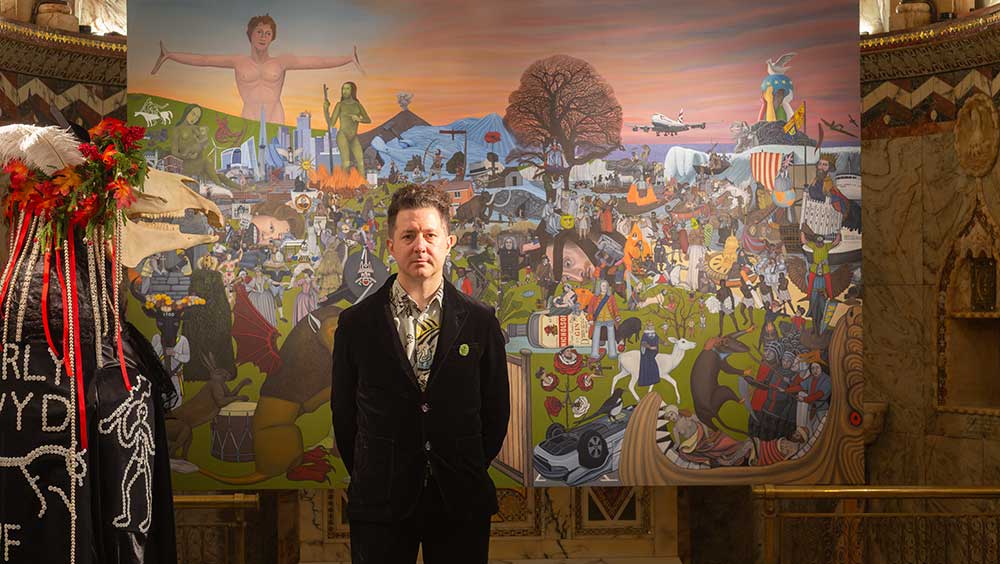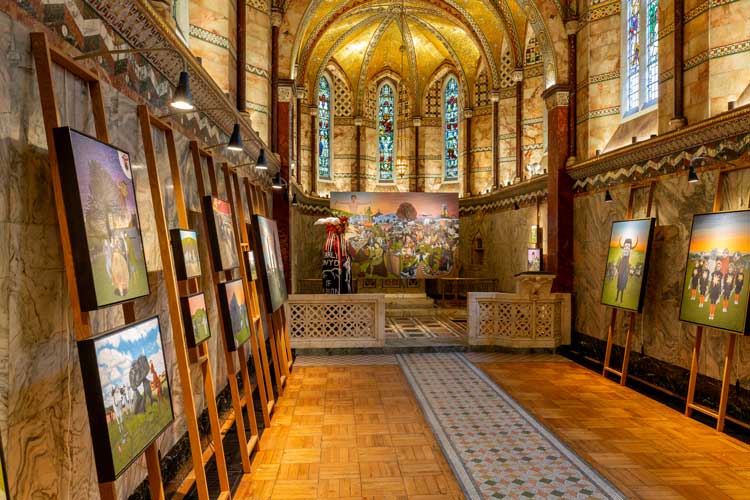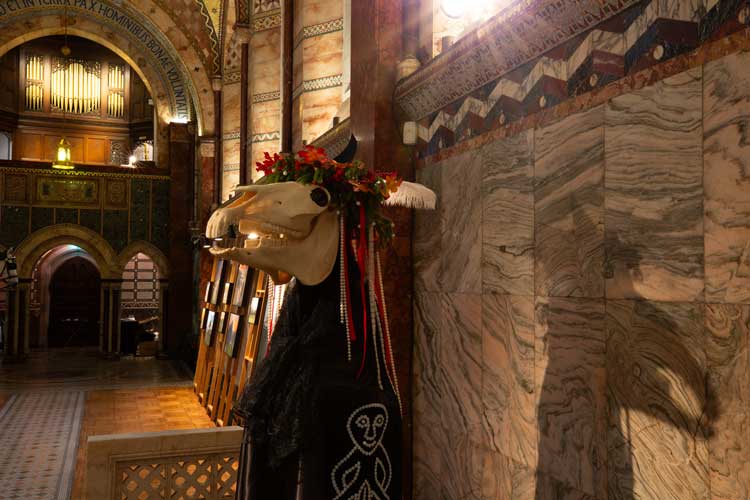
Ben Edge: Children of Albion. Photo: Sylvie Tata Photography.
Fitzrovia Chapel, London
6-26 November 2025
by CHRISTIANA SPENS
Ornate, intimate and with a sense of the mystical, the Fitzrovia Chapel is a clever choice for Ben Edge’s new exhibition, Children of Albion. Inspired by Byzantine architecture, and originally a hospital chapel, it is hidden away in central London, incongruous among the office buildings and luxury apartments that now surround it. But this strange juxtaposition is precisely what makes entering it so magical, and that sense of some hidden place of solace and beauty is central to the vision of Edge’s artistic project.
Building on his recent shows at the Museum of London and the Wilson Art Gallery and Museum in Cheltenham, his film 2021 Frontline Folklore, and his 2024 book Folklore Rising: An Artist’s Journey Through the British Ritual Year, which documents British folk customs through photography and painting, this latest show brings together a select group of paintings that encapsulate Edge’s style and concerns.

Ben Edge: Children of Albion, installation view, Fitzrovia Chapel, London, 6-26 November 2025. Photo: Sylvie Tata Photography.
Lining the walls of the chapel, each painting records a folkloric ritual or pilgrimage of some kind. In Dreaming at Rudston Monolith (2024), people gather under the moonlight in the cemetery that is home to the monolith, the tallest standing stone in Britain. In The Dorset Ooser (2022), Edge takes a folkloric ritual, in which villagers in Melbury Osmond, Dorset, would use a horned effigy to shame community members they deemed to have behaved badly, and combines the past with the present, by depicting the historic baying mob, a group of morris dancers, plus a person in dark robes and trainers who is wearing the Ooser mask. In this eery-looking painting, he shows how communities evolve while retaining elements of ancient rituals in contemporary life.

Ben Edge: Children of Albion, installation view, Fitzrovia Chapel, London, 6-26 November 2025. Photo: Sylvie Tata Photography.
The centrepiece of the show, Children of Albion (2025), which stands as a dramatic altarpiece in the chapel, is Edge’s most ambitious work yet; a fascinating visual history of Britain, encompassing prehistory up to the present, and revealing how waves of cultural exchange, conflict and evolution have shaped us. Featuring, among others, Vikings, miners, refugees, colonialists and the sleeping giant of Albion awaking, it is a vision of a conflicted and fractious Britain, but one in which there is still a sense of hope.
As well as building a vision of a layered, complex Britain, Edge’s paintings also celebrate what the artist calls a folk renaissance and a desire, which he shares with other artists, to use ritual and spectacle to reconnect with nature, history and one another. “As contemporary Britons, I believe we’re all part of this evolving story,” he says. “It transcends time and heritage, forming a diverse, interconnected whole. Since the pandemic, I’ve seen a renewed fascination, especially among younger generations, with folk traditions and the spiritual power of the land.”

Ben Edge: Children of Albion, installation view, Fitzrovia Chapel, London, 6-26 November 2025. Photo: Sylvie Tata Photography.
Edge’s paintings pay testament to the people involved in the folk renaissance just as much as the rituals themselves, and some of them were involved in the opening night, with dancers from the Black Swan Border Morris group performing a dance called Cuckoo’s Nest outside the Chapel under the full moon. Inside, the warm golden mosaic ceiling of the chapel complements the works’ careful depiction of sun and moonlight, around which people gather, as if the chapel itself is also part of one such ritual now, its interior a kind of moon itself.
In the paintings, Edge combines modern structures, people and references with the ancient rituals he has attended and documented, creating a vision of modern Britain that is connected with its past but still grounded in the fractious, sprawling present. Across painting, writing and film, he creates a blueprint for how people can live and find meaning, showing how it is possible to connect with folklore without eschewing modern life. Folkloric traditions and communities, he seems to say, enrich everyday lives rather than merely providing an escape from them.

Ben Edge: Children of Albion, installation view, Fitzrovia Chapel, London, 6-26 November 2025. Photo: Sylvie Tata Photography.
In his book Folklore Rising, Edge describes the moment he fell in love with the folklore movement, when during a period of personal struggle, he came across a group of Druids on Tower Hill. Seeing this ritual unfolding in the middle of a busy city, he realised that a sort of magic was available to him just as it was to those involved, and from then on, he sought to learn more and participate in these and other folkloric practices.
What emerged was a world not exactly esoteric, but rather grounded and enlightening; a means of connecting to the landscapes, whether urban or country, that he and others were drawn to. As he says: “The sacred can still be found, often hidden in plain sight, within the fabric of the modern world.”
He was inspired by William Blake’s vision of Albion, the ancient spirit of Britain which the poet imagined as sleeping beneath the physical land, dormant and waiting to be reawakened through the force of poetic imagination. As Blake writes in Jerusalem:
“O Divine Spirit! sustain me on thy wings,
That I may awake Albion from his long and cold repose.”
The original architect of Fitzrovia Chapel, John Loughborough Pearson, as a way of committing to his highest visions, reportedly used to ask himself of each of his designs, and especially this one: “Does it send you to your knees?” And though, after his death, it was his son who completed the ceiling’s dazzling design, the mosaics were fitted to meet these lofty ambitions. He created this chapel to bring visitors to their knees, worshipping not only God but also the beauty of this golden structure.
This vision, and that of Blake, resonates now in Edge’s work, just as in all the folkloric rituals that have inspired it. The suns, the moons, the ancient structures; they are all taken to be revered, to be worshipped, in this sacred way where art and spirituality converge. Putting this show together in the middle of a bustling city, Edge gives a sense of how he felt when he first came across the Druids, revealing how easily that poetic spirit can be awoken in us all.